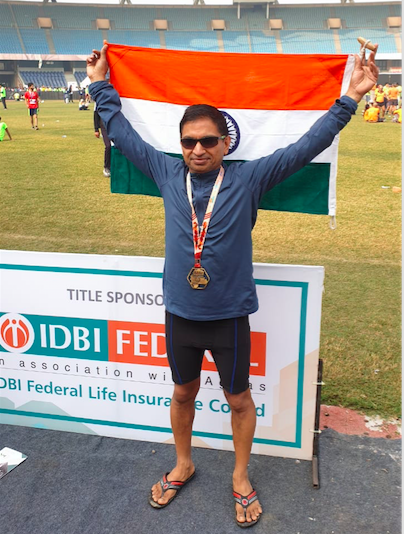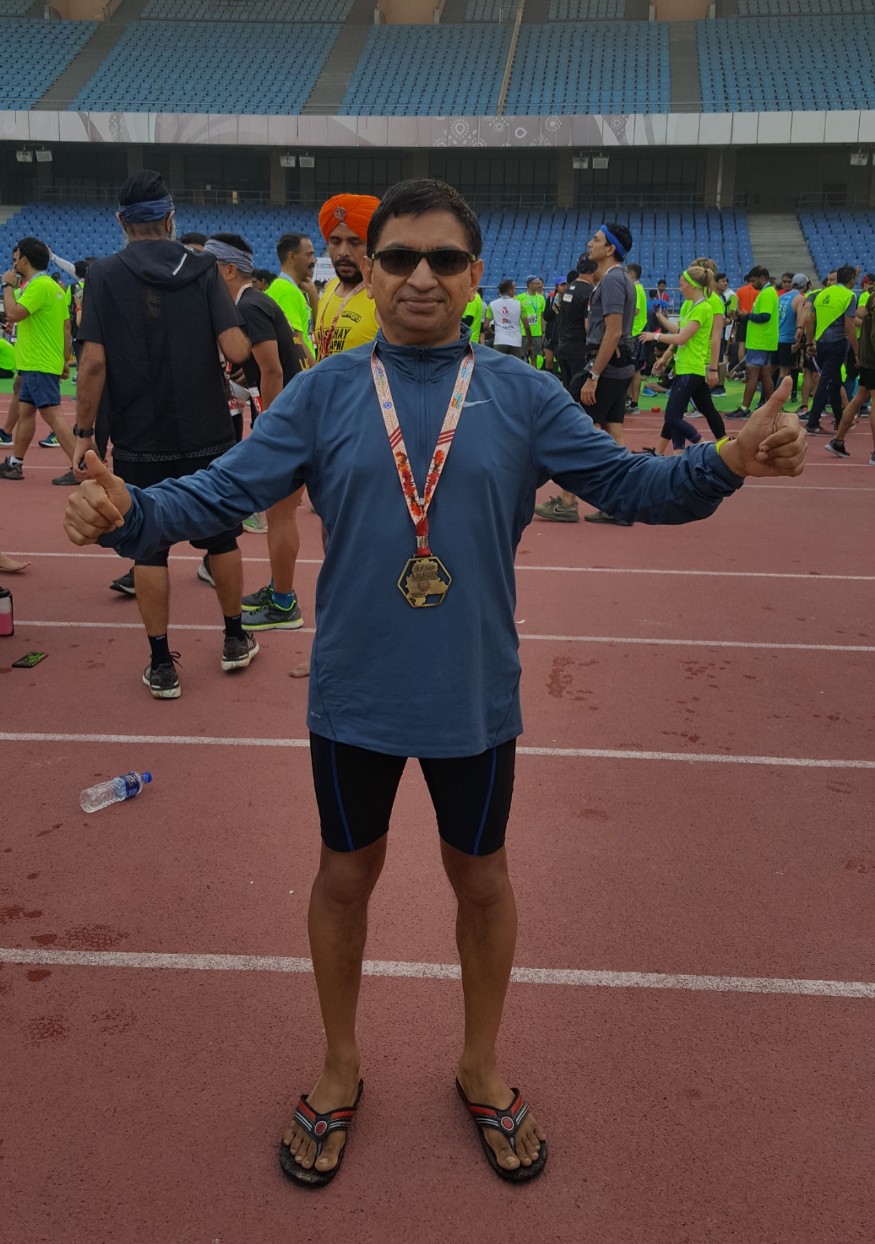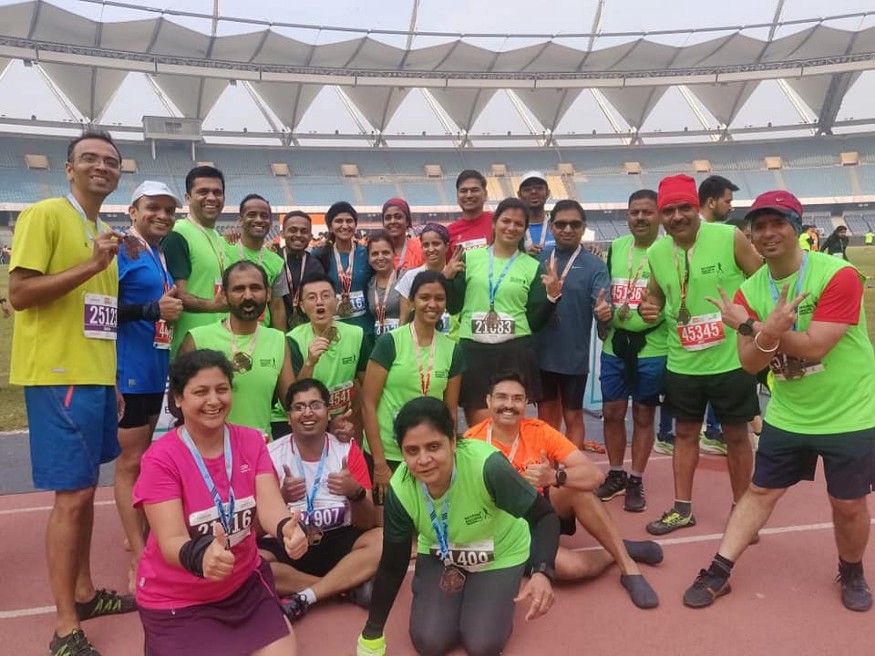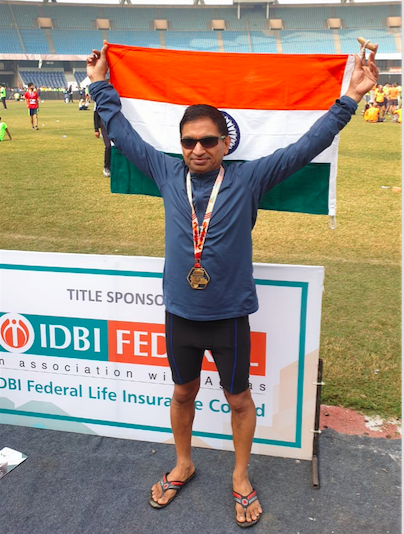Much awaited IDBI New Delhi Marathon 2020 is over. I completed it in 3hours and 40 minutes, the personal best for Marathon. This was little off the target of 3:35, the Boston Qualifier (BQ) for me, but overall very satisfied about the performance. New Delhi Marathon was the first group event of 2020 for Bavdhan Brigade. There were 33 runners from the group: 22 for Marathon and 11 for Half Marathon.
Training
Though the event specific training was for 12 weeks, it was a continuous training from more than two years with tune ups after each event. The most recent event was Hyderabad in August 2019. There was around 12 weeks of aerobic base training after Hyderabad followed by 12 weeks of event specific training for IDBI-Delhi Marathon.
The event specific training was usual 12 week program with following tune ups:
Marathon Paced Runs
We added marathon paced component at the end of the long runs. This was added to get comfortable with the event pace. The maximum marathon paced run was last 16Km in 36km run.
Longer than 42Km Run
We added one longer than 42Km run to remove fear of the distance. On my birthday some of us ran 54Km easy, some ran 51Km, some 42Km and so on. This gave everybody confidence for the distance.
Day before the event
Day before the event is very important. The rest on this day plays a vital role in the energy on the race day. Our group had very hectic day before race in Hyderabad and it affected performance of the Marathon runners. We made sure this issue is not repeated.
We landed in Delhi at 9:30am, went directly to the expo and collected the bibs. Next stop was the carb heavy lunch at AP Bhavan canteen, such a tasty, heavy but simple food. We went to hotel and caught up on some sleep. I had been selected for lunch and chat with Sachin Tendulkar, a promotional event by NEB sports and New Delhi Marathon. The event was at Park Hotel in Connaught Place from 1:30pm to 4:30pm. I decided to skip it for the afternoon nap considering the hectic week. This rest can not be quantified, but it has definitely helped me conserve and regain the energy.
Cold Weather Preparation
Earlier in the week, weather in Delhi was cooler. The plan was to wear in layers and pieces so that as body temperature rises over the distance, the layers and pieces can be removed. First layer was a sleeveless TShirt, arm sleeves and Bandana. Top layer had custom made TShirt with velcro in front for easy removal on the run. On the race day the weather was not very cold. All the extra pieces of top layer T-shirt, bandana and arm sleeves were removed within 5km. But the strategy was good and executed to the perfection. This will be useful for any cold weather marathon in future.
Fuel and Hydration
Fueling and hydration started immediately after waking up 2.5 hours before start time. I had early breakfast and electrolytes in first hour, activate drink 15 minutes before and one gel 5 minutes before the start time. The on-road stock had two 200ml bottles of gatorade, one 150ml bottle of gels loaded with 4 gels and water, one 150ml bottle water and salt caps. I also carried post-run fuel in fuel belt. Post-run fuel had a recover tablet and protein powder sachet. This is a lot of load to carry for 42km, but this makes sure all bases are covered from start to finish. I reduced the load enroute by throwing the two 200ml bottles after use during run. This helps me run non-stop without any stop at water stations. I still had to reduce pace twice for Volini spray on calves. With enough electrolyte loading and nice Delhi weather, 150ml water was more than enough. Water was used mainly to gulp salt-cap and for post gel sips. I also managed with just 100ml of electrolyte and threw the electrolyte bottles on the route to reduce the load.
Footwear

I used my custom footwear which is extremely close to the barefoot running. It protects ball of the foot area from the impact as well as minor sharp objects on the road. Rest of the foot is not protected, but rest of the foot anyway does not take much impact during run. The extreme minimalist style of this footwear keeps the cadence higher like barefoot and provides basic protection.
Execution and Analysis

Pacing plan was to run first 16km at the pace of 5:10, next 16km at the pace of 5:00 and last 10.x km at the pace of 4:50 or the best pace depending on the situation at that time. First two segments of 16km each went as planned. Third and last segment did not work out as planned. Two factors contributed to the fade in this segment. First one was the fatigue and mental calculation for surviving the remaining distance. This made me conservative and did not give extra push for going at planned pace. Other factor was the pain signals from the lateral calf muscle of the right leg. This muscle had been giving issues towards end of the training, but was able to get it recovered enough with rest and massage. Delhi route is completely flat. This puts entire load on calf muscles. On the routes with ups and downs, quads and hamstrings shares some load from calf. The extra load of flat route on already fatigued right calf muscle took it almost on the verge of cramping. This made me go conservative. Luckily there was no cramp during or after the run.
During last few km, I stopped looking at the watch for pace/HR and ran by the feel. Looking at the HR and energy left after the run, I realised that HR had dropped significantly in last 4 km. I should have pushed further if I had looked at my HR during this segment. It is very difficult to perfect all these things even with perfect planning. The refinement will come after running several marathons. For now this was the best which can be done, but there is enough to learn and improvise for the next event.
Takeaways
Due to age and physical limitations, I need to fire on all the cylinders to get best time in FM. This was the best I could do in preparation and execution. The route, weather, crowd management was at its best. But something was still missing. The difference of 5 minutes for missing BQ can be contributed to two factors: extra distance of 500 meters which added 2:30 minutes to the time and I did not push hard enough in the last few km which could have saved 2:30 minutes.
Instead of finding excuses, I will take following takeaways and work on the issues for the next event.
- Analyse and strengthen the weak links in running muscle chains.
- Increase aerobic capacity
- Analysis of physiological parameters during run and experiment with improvisations.
- Use feel and physiological parameters both till end of the race.
Overall perfect event. Everybody from the group did their personal best. The outstation events for Bavdhan Brigade are always full of fun. The performance in the event is always the outcome of rigorous training and perfect planning. Thank you all the mentors and running buddies.



